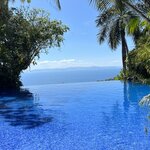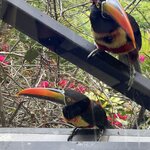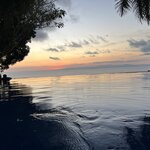Highlights
- Visit a jaguar rescue center in Puerto Viejo
- Enjoy a waterfall hike in Arenal Volcano National Park
- View flocks of scarlet macaws at Carara National Park
- Explore the secluded Osa Peninsula and Corcovado National Park
Brief Itinerary
| Day | Highlights | Overnight |
|---|---|---|
| Day 1 | Arrive in Costa Rica - Experience San José's Culture and History | San Jose |
| Day 2 | San José - Transfer to Turrialba Region | Turrialba |
| Day 3 | Transfer from Turrialba to Puerto Viejo | Puerto Viejo de Talamanca |
| Day 4 | Sloths, Monkeys & Beach Time | Puerto Viejo de Talamanca |
| Day 5 | Puerto Viejo to Sarapiquí | Sarapiquí |
| Day 6 | Transfer from Sarapiquí to La Fortuna | Arenal/La Fortuna |
| Day 7 | Volcano Hike & La Fortuna Waterfall | Arenal/La Fortuna |
| Day 8 | La Fortuna to Carara National Park | Carara National Park |
| Day 9 | Carara National Park Guided Tour | Carara National Park |
| Day 10 | Transfer from Carara to Dominical & Uvita | Dominical |
| Day 11 | Free Day in Dominical | Dominical |
| Day 12 | Dominical to Osa Peninsula - Explore Bahía Drake | Corcovado National Park |
| Day 13 | Corcovado National Park Hike | Corcovado National Park |
| Day 14 | Snorkeling & Scuba Diving at Isla del Caño Biological Reserve | Corcovado National Park |
| Day 15 | Osa Peninsula to San José | San Jose |
| Day 16 | Depart San José |
Detailed Itinerary
Day 1: Arrive in Costa Rica - Experience San José's Culture and History

Welcome to Costa Rica, the land of pura vida! After arriving at Juan Santamaría International Airport in San José, a local representative will meet you and escort you to your hotel. The rest of the day you'll have free to explore the city at your leisure.
Perhaps take a stroll through Mercado Central (Central Market), featuring over 200 shops, food stalls, and sodas (traditional restaurants). Then visit the Catedral Metropolitana (Metropolitan Church), whose interior combines Greek Orthodox, neoclassical, and Baroque styles, and features wood carvings and stained-glass windows. There's also a pair of popular museums in San José: Museo del Oro Precolumbino (Pre-Columbian Gold Museum), and Museo del Jade—the world's largest collection of pre-Columbian jade artifacts.
Be sure to explore Barrio Amón, a historic neighborhood home to cafetalero (coffee grower) mansions built during the late 19th and early 20th centuries. Many of this area’s historic buildings have been converted into hotels, restaurants, and galleries, making Amón a popular bohemian district.
For dinner, opt for a restaurant in the hills of Escazú. This elevated region on the western edge of the city offers panoramic views of the valley below. That said, San José is filled with great restaurants serving everything from traditional to forward-thinking fusion cuisine.
Day 2: San José - Transfer to Turrialba Region

After breakfast, you'll pick up your rental car outside the hotel's reception area. This is where your Costa Rican road trip begins, as you'll drive just east of the city to the Turrialba and Irazú volcanoes. This volcanic region abounds with nutrient-rich soil, which facilitates the growth of local crops, including one of Costa Rica's most famous exports: coffee. The volcanoes here are active, too, and although they occasionally erupt in a spectacle of light and fire, they don't threaten nearby populations.
After this excursion to view the volcanoes, you'll check into your hotel in the area and can spend the remainder of the day relaxing.
Day 3: Transfer from Turrialba to Puerto Viejo

After breakfast, you'll hop in the car and drive from Turrialba to Puerto Viejo, a laid-back village on the southern Caribbean coast with some epic surf beaches. Once you arrive and check into your hotel, you can grab dinner at one of the many restaurants or sodas (small local diners) this melting pot has to offer. You'll find Caribbean cuisine, fresh seafood, traditional Tico (Costa Rican) fare, and more. We recommend Chile Rojo for a beachfront dinner of Asian fusion and seafood, or Afro-Caribbean food at Restaurante Johanna.
At night, this sleepy town comes alive with the sounds of calypso and reggae. Check out local hotspots like Tasty Waves, Johnny's Place, or The Lazy Mon for live music and dancing. Or perhaps just sip on tropical cocktails at one of the many spots along the beach.
Day 4: Sloths, Monkeys & Beach Time

This morning, you'll head to the Jaguar Rescue Center, a home and rehabilitation facility for ill, injured, and orphaned animals. The center was named after a baby jaguar that was rescued back in 2007. While your chances of seeing a jaguar at the center these days are slim, you will see monkeys, wild cats, three-toed sloths, and anteaters, among others. The center offers public and private tours of their facilities—a treat for animal lovers of all ages.
The rest of the day is for lazing on the beach or browsing the boutiques of Puerto Viejo. Another option is to explore the Gandoca Manzanillo Wildlife Refuge, which includes several rare habitats like lowland rainforests, wetlands, and mangrove swamps, as well as a beautiful stretch of beach. The refuge is the nesting area for several species of turtles, manatees, crocodiles, caimans, tarpons, and dolphins.
Day 5: Puerto Viejo to Sarapiquí

Today, you'll transfer to the Sarapiquí region, which is located in the northeast of the country. It's a rich agricultural area that produces a number of things including pineapple, peach palm, guanábana fruit, and more.
You'll have the afternoon free to enjoy the hotel facilities or take any tour/excursion available in the area. You can visit a cacao plot in the La Tirimbina Biological Reserve, where you'll learn how chocolate is produced and enjoy samples of the product. If you're up for an adventure, you can go whitewater rafting on the Sarapiquí River or soar over the treetops on a zip line tour in the rainforest.
Day 6: Transfer from Sarapiquí to La Fortuna

Now you'll make your way from Sarapiquí to La Fortuna, the home base for excursions to Costa Rica's most famous volcano, Arenal. If you'd like, you can break up the long drive with an adrenaline-filled whitewater rafting trip on the Río Pacuare. By the time you do reach La Fortuna, you'll likely be hungry. The town is home to over 100 restaurants, so there's no shortage of options.
A few restaurant recommendations in La Fortuna include:
- Don Rufino, which serves a mix of local and international flavors in charming digs that include an open-air bar overlooking the main street.
- Cafe Mediterraneo, a friendly osteria serving up homemade pasta and pizza.
- La Parrilla de Maria Bonita, a must-visit for perfectly cooked steak as well as Mediterranean dishes like falafel and baba ghanoush.
- Rancho Perla, a popular open-air restaurant (you may even spot sloths hanging from the nearby trees) serving well-prepared Costa Rican staples.
- Ave Del Paraiso, which offers daily theme dinners such as Italian, Mexican, Mediterranean, and Costa Rican.
Chat with a local specialist who can help organize your trip.
Day 7: Volcano Hike & La Fortuna Waterfall

In the early afternoon, you'll head towards the base of the volcano to hike Arenal 1968. This is a network of trails named after Arenal's last major eruption. The event was so catastrophic it transformed some of the region’s topography, and lava fields now dominate one side of the volcano. The trails wind through those lava fields as well as the surrounding rainforest. Along the way, you'll find lookout points featuring prime views of Arenal.
Later in the afternoon, you'll experience the other star of the Arenal Volcano region: La Fortuna Waterfall. If Arenal is the most famous volcano in the country, then La Fortuna is easily the most famous falls. It's located a 15-minute drive from the town of La Fortuna, at the base of the dormant Chato Volcano. The waters here plunge 210 feet into a tropical lagoon, and a 500-step downhill hike provides the opportunity to see the falls from the bottom up. Besides taking photos, be sure to swim and relax in the La Fortuna River below the falls.
Then it's back to your hotel where you'll spend the rest of the day unwinding. If you want to treat yourself to a soak in the nearby hot springs, no one will blame you.
Day 8: La Fortuna to Carara National Park

In the morning you'll transfer about an hour south to the tiny (just 53 square kilometers) Carara National Park. This area was created originally as a protected area in 1978 but was upgraded to national park status in 1990 due to its popularity. It's easy to see Carera's appeal: the region is located between the tropical dry scrub of the northern Pacific coast and the southern Pacific rainforests, making it home to a wide variety of flora and fauna.
Some 360 species of birds call this area home, most famously the scarlet macaw. Travelers come from far and wide to see what constitutes the largest remaining wild population of these birds in the country. After checking into your hotel near the park, you can spend the remainder of the day relaxing. In the evening, head to the adjacent town of Quepos for dinner and sunset views. Try the famous seafood here—it's as fresh as it comes.
Day 9: Carara National Park Guided Tour

After breakfast, you will transfer to Carara National Park for a guided tour. This national park comprises more than 11,600 acres and is home to some 48% of Costa Rica's bird species, including the main attraction, the scarlet macaw. The reason for this wide variety of species is because the park is located in the transitional area between tropical dry forest and the humid Pacific rainforest. Besides birds, you're sure to spot white-faced and howler monkeys, toucans, and iguanas.
At the end of the tour, you'll take a break for lunch before heading back to the hotel. You'll then have the remainder of the afternoon free to relax.
Day 10: Transfer from Carara to Dominical & Uvita

This leg of the trip continues down the Pacific coast, with the deep green tropical rainforest to one side of you and the endless blue of the Pacific Ocean to the other. After a couple of hours, you'll reach the beaches of Dominical and Uvita, the latter of which features a thin promontory that resembles the shape of a whale's tail. During a stop, you can embark on a nature excursion or even a hike to the nearby Nauyaca Waterfalls.
This area is also where you'll find Marino Ballena National Park, a small marine protected area great for whale watching. If you happen to visit between mid-July and mid-November or mid-December to April, you can observe the humpback whales that migrate from south to north (or vice-versa depending on the season). You'll overnight at the nearby beach community of Dominical.
Day 11: Free Day in Dominical

The agenda for today is leisure and more leisure. You can spend the morning/afternoon poolside at the hotel with a tropical cocktail in hand, or head back to Uvita to while away the hours lounging on the beach. You can also partake in an optional tour. These include:
- Corcovado National Park hike. Avid trekkers will not want to miss this chance to visit one of Costa Rica's most remote and untouched national parks: Corcovado. On this day tour, you'll hike through virgin rainforests abounding with exotic wildlife like howler monkeys, sloths, scarlet macaws, and even jaguars. The number of visitors allowed per day is regulated and reservations fill up quickly, so inquire before booking your trip.
- Cano Island snorkeling tour. This tour combines two magnificent jewels of Costa Rica: the Caño Island Biological Reserve and Violin Island. On this day tour, you'll observe an abundance of marine life in their natural habitat. This includes whales, dolphins, sea turtles, and marine birds. You'll also be able to snorkel around one of the healthiest coral reefs on the Pacific coast Afterward, you'll transfer by boat 30 minutes to Violin Island, a secluded island bordered by the mangrove forests of the Sarapiquí River. Your guides will prepare a picnic lunch, then the rest of the time will be spent swimming in the bay and hiking on the beach.
- Horseback ride to the Nauyaca Waterfalls at Dominical. This grouping of impressive waterfalls plunges some 45 meters (147 feet) into a lagoon perfect for swimming. A horseback excursion gets you here, and there are rock outcroppings that make ideal diving spots.
Day 12: Dominical to Osa Peninsula - Explore Bahía Drake

In the morning you'll drive south to the village of Sierpe, which sits at the mouth of the Sierpe River and is a base for excursions to the secluded Osa Peninsula, one of the least developed regions in Costa Rica. You'll catch an early-morning ferry to Bahía Drake (Drake Bay), the main village on the north end of Osa. It's also the gateway to the famed Corcovado National Park, located directly south of Drake. This famous protected area is known for its virgin rainforests and wind-swept beaches, which are all the more evocative due to the relative lack of crowds.
Upon arrival to Bahía Drake, check into your hotel. You'll now have the entire day to relax and enjoy the beaches until your heart's content. At night, tuck into dinner at your lodgings. Drake's remoteness and limited restaurant options mean most accommodations offer all-inclusive meals.
Day 13: Corcovado National Park Hike

Today you'll venture into Corcovado National Park on a scenic half-day hike. This rigorous but moderate trek will take you mostly along Corcovado's rugged coastline. The route covers a number of hiking trails leading eventually to Punta La Chancha. The coastal rock outcroppings here jut out of the water like the spiked backbone of a giant prehistoric reptile.
The trails will also take you into both secondary and primary rainforest. Corcovado is known as one of the most biodiverse places on earth, and you'll learn this first hand as you walk through the jungle and glimpse the abundant and exotic wildlife in the area. It's not uncommon to witness tapirs cooling off in nearby mud holes or herds of peccaries roaming just a few meters away.
You'll also spot other endemic animals like howler and capuchin monkeys, and exotic birds like toucans, trogons, and scarlet macaws. If you get really lucky you might spot a jaguar or puma. Each hiker will carry a packed lunch, and additional refreshments will be served at the end of the hike in mid-afternoon. You'll then return to La Leona where you'll overnight.
Day 14: Snorkeling & Scuba Diving at Isla del Caño Biological Reserve

Today, you'll explore the waters of the Caño Island Biological Reserve (Isla del Caño) on a scuba excursion. This protected marine area is located just off the northern tip of the Osa Peninsula, next to Bahía Drake. There isn't much wildlife on the island itself, but underwater it is a different story. It's home to an abundance of marine life including reef sharks, sea turtles, parrot fish, eels, manta rays, puffer fish, snappers, sea cucumbers, octopus, and many more. There's also a wide variety of coral-building organisms and 19 different species of coral.
The excursion to Isla del Caño begins with you boarding a 30-foot Island Hopper, at which time an expert will offer a safety lesson geared for all ages and experience levels. Then it's time to plunge into the water. Visibility is 30-100 feet throughout the year, making Caño Island a perfect site for underwater photography. For those that are not certified divers, don't worry; there will be snorkeling equipment available as well.
Day 15: Osa Peninsula to San José

In the morning you'll transfer to the airport for your flight from the Osa Peninsula back to San José. After checking in at your hotel, you'll have the rest of the day to explore and catch any of the sites and museums you may have missed the first time around.
Day 16: Depart San José

It's time to say adiós to Costa Rica. Depending on your departure time, you'll have the morning to explore more of San José, relax in a café, and/or browse some shops before boarding your flight home.








